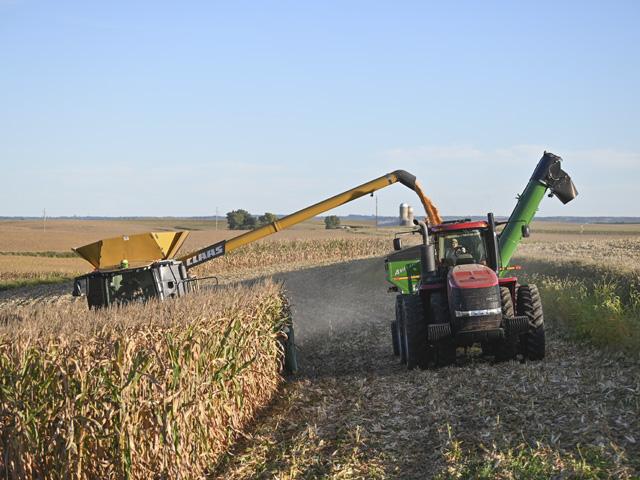Cash Rents on the Rise in 2023
2023 Cash Rents Climb; Bankers Worry About Impact on 2024 Budgets
OMAHA (DTN) -- A few farm operators have offered $500- to $600-per-acre cash rent in eastern Iowa, said Mike Hein, vice president of Liberty Trust and Savings Bank in Durant, Iowa, at the Agricultural Bankers Conference earlier this week.
"Of course, that is not typical, and these high offerings have specific reasons for that amount going into 2023," Hein told DTN, adding corn on that type of ground would yield from 225 to 275 bushels per acre (bpa). "In fact, you may be able to pencil out $500- to $600-per-acre cash rent for 2023 in our area, but not beyond."
Banker Nick Luchsinger, with First Dakota National Bank in Columbus, Nebraska, said cash rent on excellent irrigated farmland in eastern Nebraska may top $300 per acre for 2023.
Mike Budach, vice president and senior ag lender with Arcadian Bank in Albert Lea, Minnesota, told DTN about a farmer who wanted to rent some more ground and inquired about a farm in the area. The landowner wanted $500 per acre for 2023 -- not an amount that farmer was willing to pay.
More typical top rents will likely be $300 to $350 per acre for ground that produced 250 bpa corn and 70 bpa soybeans in 2021 and 220 bpa corn and 60 bpa beans in 2022, said Rick Goettlich, senior credit officer and senior vice president of United Prairie Bank in Mankato, Minnesota.
In southeast Iowa, cash rents are up 30% heading into 2023, reported Dan O'Rourke with County Bank in Sigourney, Iowa.
"Top cash rents are up to $325 to $375 per acre and on multi-year leases," he said. This is on ground that has a 60-76 corn suitability rating (CSR-2) and can produce around 200 bpa corn. Hog farmers in the area are expanding and looking for ground to spread manure. Hog buildings are still going up around us," said O'Rourke.
P[L1] D[0x0] M[300x250] OOP[F] ADUNIT[] T[]
In Lee County, also in southeast Iowa, Mason Holvoet with Steffes Group, an auction company, told of a 400-acre tract cash-renting for $450 per acre, locked in for three years. The farm's productivity CSR-2 is in the high 80s.
FARMLAND VALUES DRIVING THE MARKET
Cash rents are following land values higher.
Four out of five ag lenders reported rising land values in 2022, according to a survey of 300 agricultural bankers conducted by the American Bankers Association and Farmer Mac, a secondary market provider for ag loans.
However, land value changes pulled back somewhat in the South and West in 2022, as profitability in those regions lagged compared to the Midwest.
Looking forward, lenders in all regions expect generally steady land values in the coming year, with a slight tilt toward small gains. These results are consistent with the average expected change in land value of 3.5% for 2023. The rising interest rate environment is likely a major factor in the slowing of land value appreciation, but lenders still see some upward pressure, the report noted.
HIGHER INTEREST RATES LOOM
With higher direct input costs and higher cash rents, a concern in 2023 for many bankers attending the annual ABA Agricultural Bankers Conference will be refinancing debt that's maturing in the next year and managing the balance sheet, said Brian O'Rourke, a senior relationship manager in Commercial Business Development at Farmer Mac.
Neil Stanley, founder of CorePoint and president of Community Banking at TS Banking Group in Omaha, Nebraska, said farmers have been living off the surge in commodity prices since the pandemic.
"We know the good times we've enjoyed aren't going to be sustained," he said.
Farmers would be wise to develop their relationship with their banker "and strengthen your financial situation for the coming storm," said Anthony Hotchkiss, executive vice president and director of agricultural banking with Regions Bank in Clayton, Missouri. "I can't emphasize enough how important it will be for ag producers to know their cost of production and watch their financial situation closely."
Although bankers are in the business of lending money, attendees who DTN interviewed at the bankers' conference this week said there may be one more year of profitability in corn and soybean production, but cash will become king in 2024 if input prices remain high, commodity prices drop from a worldwide recession and/or rebounding world grain and oilseed supplies, U.S. government support lags and interest rates remain strong.
In other words, "Save your cash," advised Albert Lea, Minnesota, banker Budach.
Susan Payne can be reached at susan.payne@dtn.com
Follow her on Twitter @jpusan
(c) Copyright 2022 DTN, LLC. All rights reserved.




